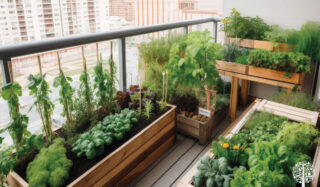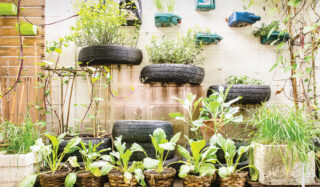How To Plant An Urban Garden And Why It’s Important
Urban gardening is on the rise as city-dwellers look to beautify and cool their surroundings and access affordable and nutritious food sources. But what exactly is an urban garden? Do they have to be a specific size, and what can you grow in them? Is urban gardening complicated? Let’s break it down from the top.
What’s An Urban Garden?
Urban gardens are typically small-space growing areas within city limits. Planting in containers, grow bags, or vertical gardens on balconies, rooftops, small patios, windowsills, or in a few compact raised beds on a plot of land qualifies as urban gardening. Indoor vertical or hydroponic farms and community gardens with several raised beds and containers also fit the description. An urban garden is any growing space in a suburban or city neighborhood, whether in soil, water, or another substrate.


What Is An Urban Gardener?
An urban gardener is anyone who tends to these growing spaces. They plant the seeds, water and feed the plants, weed the garden areas, and harvest the fruits. Don’t worry; if you’ve had a few unsuccessful attempts at growing, you are still an urban gardener! All gardeners kill plants, are plagued by pests and disease, or suffer poor yields at some point in their growing careers. Learning from these mistakes and honing your skills as you continue your growing ventures is essential and part of being a gardener.
Why Is Urban Gardening Important?
There are many reasons why urban gardening is essential:
- Urban gardens bring fresh, nutritious, affordable food to cities and reduce food miles.
- Urban gardens help reduce the heat island effect, cooling cities typically surrounded by concrete and paved surfaces.
- Urban gardens bring green and beauty to backyards, balconies, and windowsills. Being surrounded by nature is proven to help boost moods and reduce stress and anxiety.
- Urban gardens can act as beautified privacy fences.
- Urban gardens create a community and teach essential life skills in spaces where many neighbors or schools get involved.
- Urban gardens often use upcycled materials to maximize a space, which is super cool and unique.


What Can Be Grown In An Urban Garden?
You can grow almost anything in an urban garden, but always consider the available space. If you have tight quarters, micro-veggies are a fun alternative to indeterminate or full-size crops. Dwarf tree and shrub varieties exist for smaller yards; some grow well in containers! If all you have is a countertop or windowsill, consider growing microgreens and sprouts, which are incredibly nutritious, fast-growing, and nutritious!
Can An Urban Garden Follow A Theme?
Yes! Like gardens and farms in the countryside, urban gardens can be unique and follow various themes on a smaller scale. Ideas include:
- Sensory gardens
- Cottage gardens
- Medicinal herb gardens
- Herb spirals
- Meditation gardens
- Shade gardens
- Moon gardens
Urban gardens don’t have to be complicated! Start small and grow plants that you love! You’re already an urban gardener; now it’s time to get growing and beautify your surroundings.
If you’re looking for some excellent urban gardening resources, keep browsing Garden Culture or pick up these books:
The Urban Garden: 101 Ways to Grow Food and Beauty in the City by Kathy Jentz and Teri Speight
Field Guide to Urban Gardening: How to Grow Plants, no matter Where you Live by Kevin Espiritu




